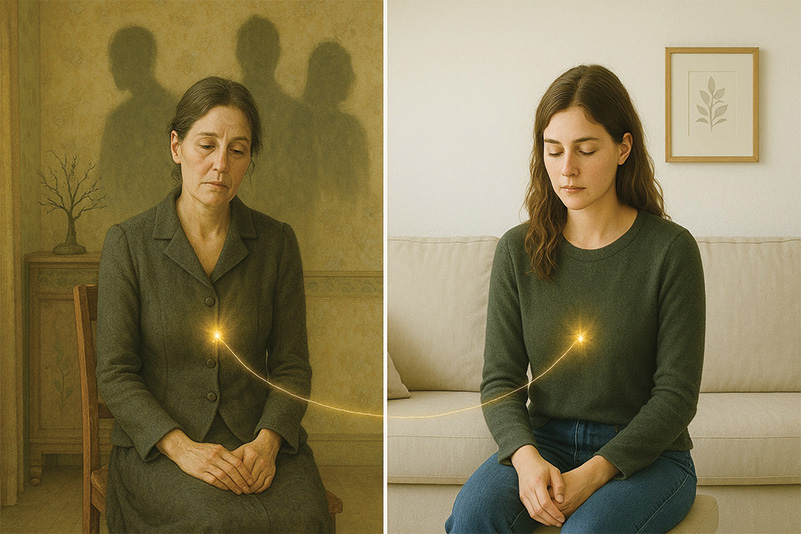One of the most misunderstood aspects of Family Constellations is what actually happens when someone steps into the role of a representative.
For those witnessing it for the first time, the process can feel almost mystical. A participant stands in for a family member they have never met, sometimes someone who has long since passed away, and yet they begin to experience emotions, impulses, and bodily sensations that reflect that person’s reality with striking accuracy.
It is natural to ask how this can happen. For many, the first thought is that it must be a form of channeling.
Bert Hellinger, the founder of Family Constellations, was often asked this very question: How does representing work? His reply was characteristically simple:
“We don’t know. We stand, we feel, and something comes. It is a mystery, and it works.” ~ Bert Hellinger
Hellinger acknowledged that people have offered different explanations. Some speak of the morphogenetic or “knowing” field, a term introduced by Rupert Sheldrake.
Others refer to resonance between representatives and the family system, the collective unconscious, or even mirror neurons. Hellinger did not reject these ideas, but he avoided settling on any one theory.
For him, the important truth was that the phenomenon can be observed, repeated, and used to bring movement toward healing. He encouraged us to stay with what is, rather than trying to explain it away.
He would often remind us:
“When you step into the place of someone else, something takes hold of you. Your body feels things, your heart feels things. You do not need to understand. You only need to allow.” ~ Bert Hellinger
Because the experience can seem mysterious, it is important to make a clear distinction. Channeling and representing may appear similar at first glance, but they arise from different sources and lead to different kinds of information. Understanding this difference ensures that constellation work remains true to its purpose and integrity.
Channeling
Channeling is more often used in spiritual and metaphysical contexts. A channeler acts as a conduit for information or energy from a non-physical source, for example a spirit guide, ancestor, deity, or collective consciousness. The focus is often on receiving and delivering a message that originates beyond the person’s ordinary awareness.
In channeling:
- The source is perceived as external
- The channeler’s own sense of self is often set aside to “make space” for the incoming message.
- The content is frequently verbal or visionary, rather than arising through the body’s physical sensations.
- It may or may not be directly connected to the client’s current systemic reality.
Channeling has its own traditions and disciplines, and for many people, it can be deeply meaningful. But it is not the methodology of Family Constellations.
Representing
Representing in Family Constellations is a grounded, embodied process that takes place within the systemic field: the invisible web of relationships, loyalties, and unresolved events that shape a family system.
When someone steps into the place of a father, grandmother, unborn child, or even an inanimate or abstract or element like “a home” or “shame,” they are not “becoming” that person in the mystical sense. They are tuning into the relational field, allowing their body, emotions, and impulses to respond to the information present there.
In representing:
- The source is relational and systemic: it emerges from the interconnectedness of the client’s family system.
- The representative remains themselves, simply oriented toward what they feel, sense, and notice in that position.
- The information is often felt somatically: a heaviness in the chest, an urge to step away, a sudden emotion, a desire to connect or turn.
- It is always in service of the client’s movement toward resolution: not to deliver a grand message, but to reveal hidden dynamics.
Bert Hellinger often said,
“We do not imagine; we allow.”
Representing is not about inventing a story or interpreting a vision. It’s about presence, receptivity, and letting the body be a precise instrument for what the field is showing.
Why the Distinction Matters
The difference between channeling and representing is not just a technicality: it shapes the entire process.
If a representative approaches the role as a channeler, they may start telling the client what they think is true for the person they represent, adding interpretation. This can pull the constellation away from the embodied truth of the moment and into the realm of personal or spiritual belief.
When we represent, however, we stick to:
- What we feel physically or emotionally (“I notice my chest is tight”)
- What we observe in the body (“My eyes want to look down”)
- What we spontaneously do (“I feel like stepping back”)
We don’t add, embellish, or speculate. This keeps the work clean, avoids imposing our own worldview on the client, and allows the systemic field to do what it does best: reveal the movements that lead toward healing and wholeness.
An Example from Practice
Imagine you are representing a grandmother who died young. As you stand in her place, you notice an unexpected heaviness in your arms. Without thinking, you lower them, almost as if holding a baby. You feel sadness rise.
If you were channeling, you might say:
“She is telling me she lost a child, and she wants you to know she forgives you.”
That is an interpretation, possibly powerful, but it risks moving away from the pure information of the field.
If you are representing, you simply report:
“My arms feel heavy, like I’m holding something… I feel sadness.”
The facilitator will be guided as to how to proceed. The image or sensation can ripple through the system, often leading to a moment of profound healing and integration without the need for interpretation.
The Subtle Discipline of Representing
Representing requires humility. It asks us to resist the temptation to make meaning too soon. The skill lies in staying with what is present: sensations, emotions, movements, and trusting that the systemic field will unfold what is needed.
It also demands embodiment. While channeling can often bypass the body, representing begins with it. We breathe, we sense, we stay rooted in the here and now.
In Closing
Family Constellations is not about acting, imagining, or channeling from another realm. It’s about making space for what the field: this interconnected matrix of relationships and histories is already holding.
Channeling looks outward and upward for information. Representing looks inward: into the body, into the felt sense, into the living connections between people.
When we honour this difference, the constellation remains anchored in what it needs to show, and the movements that arise are deeply aligned with the client’s system.
And perhaps this is why so many people leave a constellation saying:
“I don’t know how you knew… but you felt exactly what was there.”
It is not magic. It is presence.
Participant’s Guide: How to Represent Well
Representing is a subtle and profound act of allowing. These guidelines will help you step into a role in a constellation with clarity, presence, and respect for the process.
1. Arrive Grounded
Before stepping into your role, take a moment to feel your feet on the ground and notice your breath. Let go of expectations or preconceived ideas about the person or element you will represent.
2. Be Present, Not Performing
Representing is not acting. You do not need to dramatize or “become” the person. Simply allow whatever arises to show itself naturally.
3. Follow the Body’s Lead
Pay attention to sensations, changes in posture, or impulses to move. If your body wants to turn, step, or reach out, let it happen gently and with awareness.
4. Stay with What Is
Speak only about what you notice:
- “I feel pressure in my chest.”
- “I want to look away.”
- “My hands feel heavy.”
Avoid adding interpretation or guessing why you feel it.
5. Trust the Field
You do not need to understand why something is happening. Trust that the facilitator and the constellation will respond to what is present, allowing the process to unfolds in its own way.
6. Keep Awareness Wide
Notice not just yourself but also your relationship to others in the space: whether you feel pulled toward someone, want to turn away, or sense relief when someone moves.
7. Release the Representation Afterwards
When the facilitator invites you to step out of the role, take a breath, shake out your body if you like, or stretch. Consciously leave what is not yours with whom it belongs.





